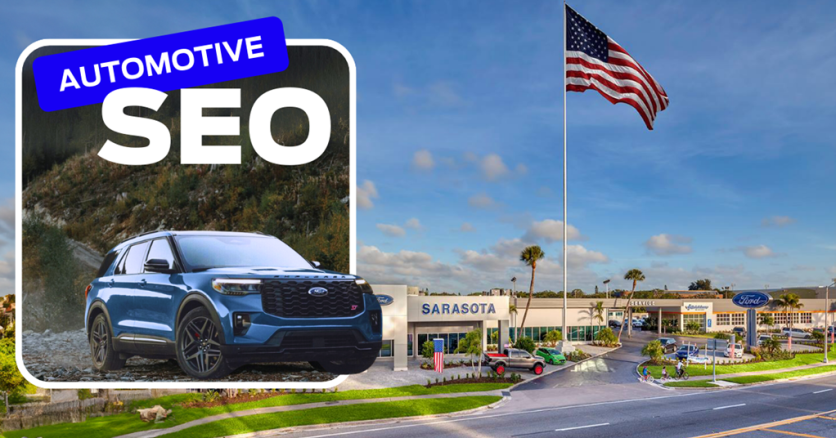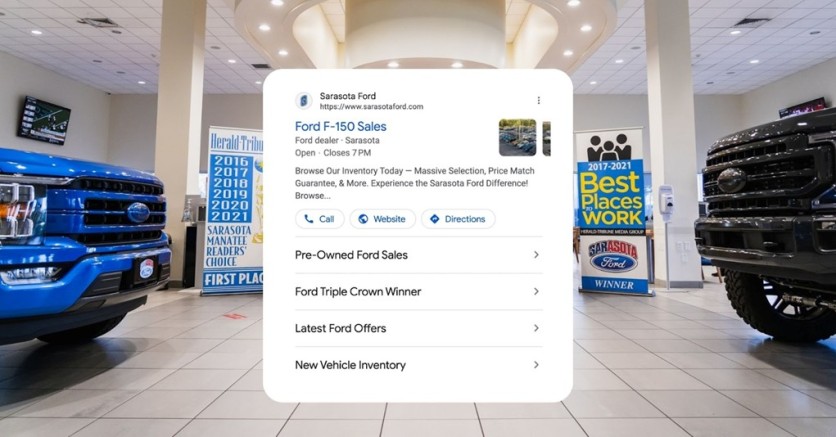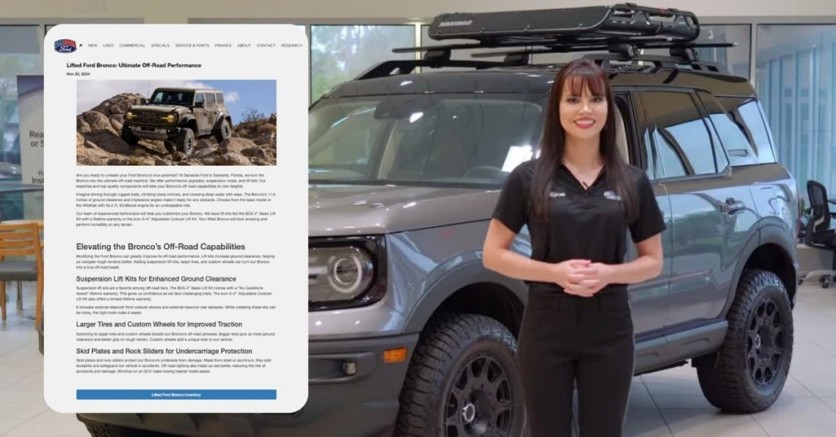
Car dealerships often struggle to stand out online. With a large majority of car buyers starting their purchase journey online, mastering automotive SEO (Search Engine Optimization) can mean the difference between thriving and merely surviving in the competitive automotive market. This article will show you how to properly use SEO to attract more car buyers to your website.
The Importance of Automotive SEO for Dealerships
Automotive SEO plays a crucial role in boosting a dealership's online presence. It improves website features like navigation, meta-tags, and content to rank higher on search engine result pages.
This matters because 90% of car buyers start their journey online, using search engines to research prices, trade-ins, and dealerships. With Google handling 90% of online searches, a strong automotive SEO strategy helps dealerships reach these potential customers.
SEO offers better value than traditional marketing methods. TV and radio ads target broad audiences, but SEO focuses on specific users actively looking for vehicles. This targeted approach creates trust, attracts intent-driven customers, and yields a higher return on investment.
As the automotive industry evolves, SEO becomes an essential tool for dealerships to stay competitive in the digital marketplace.
Next, let's explore the key elements that make up an effective automotive SEO strategy.
Key Elements of an Effective Automotive SEO Strategy
Effective automotive SEO hinges on several key elements. These components work together to boost a dealership's online visibility and drive more traffic to their website.

Keyword Research for Automotive Dealerships
Keyword research forms the backbone of any strong automotive SEO plan. Car dealers must focus on terms that match buyer intent and local search habits. This means using a mix of broad terms like "used cars" and specific phrases such as "2023 Honda Civic for sale in Chicago." Tools like Google Keyword Planner help find popular search terms and their competition levels.
Smart dealers also look at long-tail keywords. These longer phrases often show a user is closer to buying. For example, "best price on Toyota Camry with leather seats" suggests a more serious shopper than just "Toyota Camry." By targeting these precise terms, dealerships can attract visitors who are more likely to become customers.
Regular keyword updates keep content fresh and relevant to changing market trends. That is why having a good automotive digital marketing company is important.
High-Quality, Unique Content Creation
High-quality, unique content forms the foundation of effective automotive SEO. Dealerships should create engaging articles, blog posts, and product descriptions that inform and excite potential customers.
This content should focus on local events, car maintenance tips, and model-specific information. Fresh, relevant material helps boost website traffic and positions dealerships as authoritative sources in their field.
Regularly updating websites with new content encourages search engines to return and index pages. This practice improves search rankings and gives visitors reasons to return. The next key element in an automotive SEO strategy is optimizing product and model pages for maximum visibility.
Optimizing Product and Model Pages
Optimizing product and model pages is crucial for automotive dealerships to attract potential buyers. These pages serve as virtual showrooms, showcasing vehicles and their features to online visitors.
- Use clear, descriptive titles for each vehicle page.
- Include high-quality images and videos of the vehicles.
- Write unique, detailed descriptions for each model.
- Add specific vehicle specs and features in an easy-to-read format.
- Incorporate relevant keywords naturally throughout the content.
- Create separate pages for new and used vehicles.
- Add customer reviews and testimonials for each model.
- Include pricing information and available financing options.
- Optimize page load speed for better user experience.
- Use internal links to connect related models and inventory pages.
Enhancing Local SEO for Dealerships

Local SEO helps car dealerships stand out in their area. It boosts visibility for nearby customers searching for vehicles or services.
Claiming and Optimizing Google Business Profiles
Google Business Profiles are vital for car dealerships to boost local visibility. These profiles help potential customers find your business easily and learn key details about your services.
- Claim your profile: Visit Google My Business and verify ownership of your dealership's listing.
- Add accurate business info: Fill in your dealership's name, address, phone number, and hours of operation.
- Choose the right category: Select "Car Dealer" as your primary category for better search results.
- Upload high-quality photos: Showcase your dealership, inventory, and team with clear, appealing images.
- Write a compelling description: Craft a brief, engaging summary of your dealership's unique selling points.
- List your services: Include details about sales, financing, repairs, and other offerings.
- Post updates regularly: Share news, promotions, and inventory updates to keep your profile fresh.
- Respond to reviews: Thank positive reviewers and address negative feedback promptly and professionally.
- Use Google Posts: Create short, eye-catching posts to highlight special offers or events.
- Add products: Feature specific car models or services directly on your profile.
- Set up messaging: Enable the messaging feature to allow customers to contact you directly through your profile.
Generating Local Backlinks
Local backlinks are vital for boosting your dealership's online presence. These links from nearby businesses and organizations help search engines understand your local relevance.
- Partner with local car clubs for event sponsorships and website mentions.
- Create content about local automotive events and ask organizers to link back.
- Offer expert car advice to local news outlets in exchange for citations.
- Join your local chamber of commerce for a business directory listing.
- Sponsor youth sports teams or school events for community goodwill and links.
- Write guest posts for local blogs about car care tips or buying advice.
- Collaborate with nearby non-competing businesses for cross-promotions.
- Donate to local charities and request a mention on their donor pages.
- Host car care workshops at community centers and earn links from their event pages.
- Participate in local business award programs for potential backlinks.
Building Strong Review Profiles
After securing local backlinks, focus on building strong review profiles. Reviews play a crucial role in shaping consumer opinions and influencing search rankings. Here's how to build a robust review profile:
- Ask happy customers for reviews regularly.
- Make it easy to leave reviews with direct links.
- Respond to all reviews, both positive and negative.
- Display reviews prominently on your website.
- Use review management tools to track and analyze feedback.
- Encourage reviews on multiple platforms like Google, Yelp, and Facebook.
- Train staff to provide review-worthy service.
- Offer incentives for leaving honest reviews within platform guidelines.
Creating Location-Based Pages
Location-based pages boost a dealership's local search rankings. These pages target specific areas and models, helping customers find exactly what they need.
- Make unique pages for each location and car model combo.
- Use local keywords in titles, headings, and content.
- Include maps and directions to the dealership.
- Optimize meta descriptions with location and model info.
- Link to relevant local resources or attractions.
- Use schema markup to highlight location data.
- Add photos of the dealership and inventory in that location.
- Include local phone numbers and contact info.
- Optimize page URLs with location and model names.
- Link to these pages from the main website navigation.
Leveraging On-Page SEO Strategies

On-page SEO strategies boost your dealership's online visibility. These tactics focus on optimizing your website's content and structure to rank higher in search results.
Optimizing Title Tags and Meta Descriptions
Title tags and meta descriptions play a crucial role in automotive SEO. These elements help search engines understand your content and attract potential customers to click on your dealership's website.
- Create unique title tags for each page, including your dealership name and main keyword.
- Keep title tags under 60 characters to ensure they display fully in search results.
- Write compelling meta descriptions that summarize the page content in 155–160 characters.
- Include a clear call-to-action in meta descriptions to encourage clicks.
- Use relevant keywords naturally in both title tags and meta descriptions.
Structuring URLs for Better Rankings
URLs play a big role in how search engines rank your pages. Smart dealers use clear, short URLs that include key terms. This helps both users and search engines understand what the page is about.
For example, a URL like "www.dealership.com/ford-f150-2023" is better than a long string of numbers and letters.
A good URL structure also makes it easier for people to share your links. Short, readable URLs look better in social media posts and emails. They give users a quick idea of what they'll find when they click.
Implementing Internal Linking
After setting up your URLs, focus on internal linking. This practice connects your web pages to each other. It helps visitors and search engines find more of your content. Good internal links boost your SEO and keep people on your site longer.
Start by linking related pages. For example, link a car model page to its review page. Use clear, descriptive anchor text for these links. This tells readers and search engines what to expect.
Conclusion
Automotive SEO is an effective tool for dealerships to enhance their online presence. It helps reach more potential buyers and differentiate from competitors. Using smart keyword strategies and creating quality content can improve search rankings.
Local SEO tactics attract nearby customers, while technical improvements make your site user-friendly. Monitoring progress with analytics helps refine your approach. These SEO strategies can help your dealership succeed in the digital marketplace.




